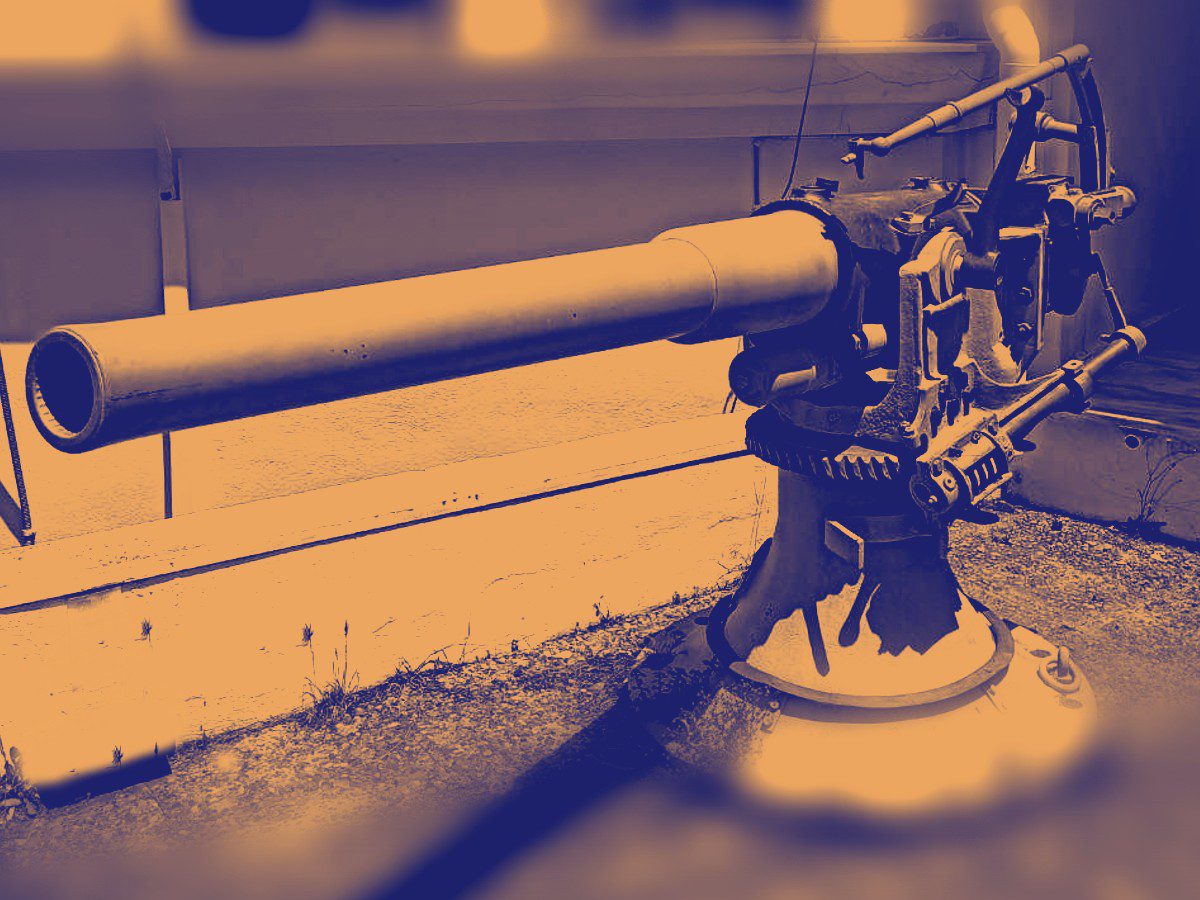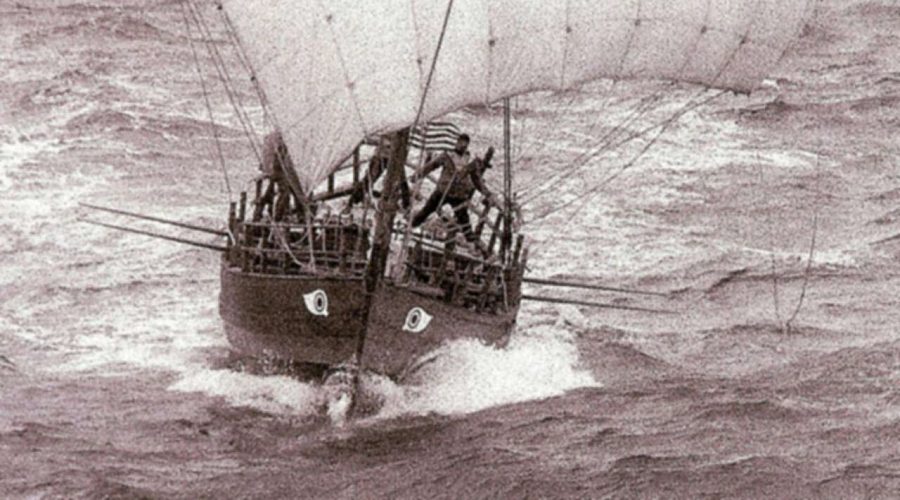
The Kyrenia II, the trireme Olympias, the papyrella : three different endeavours in nautical experimental archaeology
- 10/07/2020
- 0
This article is a brief description of why, how and to what extent the author was involved in three different Greek projects of experimental nautical archaeology in the 1980s : the Kyrenia II, an ancient Greek coaster, the trireme Olympias, an ancient Athenian warship, and the papyrella, a prehistoric papyrus raft.
It is not my intention in this article to analyse the three projects in nautical experimental archaeology that were conducted in Greece during the decade of the 1980s. To do so would require much more than the limited space of an article. In fact, the results of the Kyrenia II, the papyrella and the Athenian trireme projects have been extensively published (1). What I intend to present here is a brief story of how and to what extent I was involved in all three projects.
I would like to dedicate this short article to Patrice Pomey, who followed the different stages of the construction of the Kyrenia II, participated as scientist-observer during the navigation from Piraeus to Cyprus and expressed a deep interest in our first attempt at nautical experimental archaeology.
The Kyrenia II project
During the summer of 1981, after a careful evaluation of all the information gathered on the ancient shipwreck of Kyrenia, I decided to investigate the possibilities of building a full-scale replica of that Greek merchantman. I first contacted Manolis Psarros, a reputed boat builder in Perama, whose family is originally from the island of Symi and has for generations built traditional wooden boats. I described to Manolis what would be required for the construction of an “ancient ship” abiding by the rules of experimental archaeology. His response was positive. I then contacted Michael Katzev, the excavator of the Kyrenia shipwreck, and his wife Susan Womer Katzev, who had participated in all the phases of the project, and then later Richard Steffy, who had reassembled the ancient hull and was a world-renowned specialist on ancient shipbuilding. They enthusiastically accepted to put at the disposal of the project all information they had acquired during more than a decade of work on the ancient ship and to assist in the construction of the replica.
I was well aware of the difficulties that we had to face, the most challenging being the assembly of the hull using the “shell first” method. It should be stressed that the shipbuilders were sceptical as to the possibility of building a ship by first setting the planks of the hull and only later fastening the frames to the planking.
The challenge was great since for the last 1,500 years ships in the Mediterranean have been built “skeleton first”. But there were many more questions that needed to be answered: how would a ship with a rocked keel behave, and what about the lack of caulking, and the use of the steering oars and of a single square sail ?
What led me to decide on attempting the construction of a replica of that particular ship was that some 75 % of the timber of ancient wreck’s hull had been retrieved and preserved. The whole keel, most of the strakes of the hull planking and the frames had been preserved, as well as small portions of the stem-post and stern-post, while numerous construction details were visible. The assembly of the hull planking was achieved through an intricate method of mortise and tenons, while the frames were secured to the planks with bronze nails driven through treenails. Contrary to the traditional shipbuilding method, the frames of the ancient ship were not fastened to the keel.
With the exception of the Roman era ships of Lake Nemi, near Rome, that were unfortunately destroyed by fire at the end of the Second World War, there was no other ancient ship in the Mediterranean that was as well preserved as the Kyrenia vessel. In consequence, the construction of a full-scale replica of that ship, abiding by the rules of a scientific experiment, was not only expected to help in answering the numerous questions related to shell-first construction, but would also enrich our knowledge on how those ships with a steering system, a rig and a sail, so different from the islands’ traditional caiques (2) would behave at sea.
There would certainly be more questions to be answered, such as the storing of a load of nearly 400 amphorae, the use of long oars for manoeuvring in ports and secluded coves, the mode of anchoring. How could the captain and crew of four live on such a restricted space deprived of amenities ? How would they plan their course, hopping from one island to another deprived of the help of navigation aids ? It was hoped that those questions would be answered during the long experimental voyages.
One may wonder why I undertook such a complex, daring scientific project, a pioneering attempt in the field of Mediterranean nautical experimental archaeology. Because of my profession as a marine consultant, I was close to a variety of different types of yachts and I had also conducted research into the traditional boat building techniques of a wide variety of traditional Greek wooden sea craft.
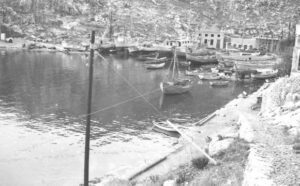
In 1967, when Andreas Kariolou, a Cypriot diver, found the wreck of a 4th century BC merchantman on the seabed in the approaches to the port of Kyrenia, I was on the island of Symi supervising the construction of five traditional caiques at the old boatyard of Dimitris Sarris, the last boat builder on the island. This was part of a desperate attempt to revive the boatbuilding tradition of Symi. The Symian trechandiris we were building were 15 metres long, exactly the same length as the ancient ship that had just been discovered in Cyprus. Both ships had similarities as well as striking differences (fig. 1).
Prior to settling in Greece, I had been fascinated by the traditional feluccas of the Nile with their tall masts and immense triangular sails, and in 1954 I had the unique opportunity of experiencing a voyage on such a vessel that took me from Cairo to the Cataracts and from there to Khartoum and back. However, it was during my travels in northern Brazil, from 1956 to 1959, that I had my first experience in ethno-archaeology, studying the construction of the jaganda of Fortaleza, a primitive sailing raft, and then discovering the dugouts of the Amazon. These were life-changing experiences.
Construction
The construction of the Kyrenia II, the replica of the ancient craft, presented other scientific as well as practical difficulties. The construction of the ancient ship must have required only three months of work, but it took nearly three whole years for Psarros’ chief shipwright, Michalis Oikonomou, and a number of apprentices to build the replica. The ship was finally launched in June 1984 and, after a number of short and extended sea trials, the long voyages to and from Cyprus began.
The construction advanced very slowly because there were constant questions that had to be answered, and equal time was spent in Athenian archaeological libraries as in the Perama boatyard. The ancient sources were most valuable, Theophrastus in particular, as well as the wide bibliography related to the iconography of ships of the Greek Classical and Hellenistic periods.
Obviously, as for all ancient shipwrecks, most of the equipment and fittings of the Kyrenia shipwreck were missing. There was no mast, no rigging, no sail, no decks, and a multitude of details had to be reproduced using iconographic evidence from vase paintings as well as graffiti representations of ships. All the intricate mechanism of the mast-step had been found on the wreck, so it was clear that there was a single mast that had an adjustable inclination. A pulley block as well as numerous lead rings and other small wooden fittings of the rig were found and had to be interpreted and replicated.
The ancient ship’s hull was all of Aegean pine and that same wood was available in Samos. So, duplicating the method used in antiquity, but also in the construction of traditional caiques up to the early 20th century, Manolis Psarros and his chief shipwright travelled to Samos to select pine trees with branches that had the required curvature to be used according to their shape for the various parts of the ship. The timber was seasoned before being adzed to the right shape (fig. 2‑4).
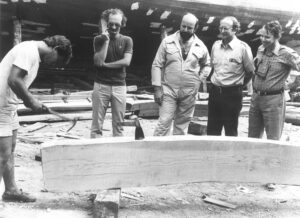

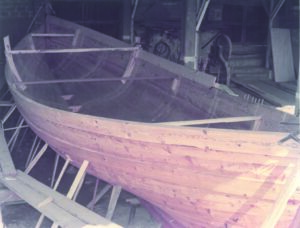
For the mast, special permission was obtained from the Department of Forests in order to fell a more than 10 metre-high cypress from a forest in Meteora, in central Greece.
One of the thousands of details that had to be investigated was the making of bronze nails : hundreds were hand-forged, one by one, by a traditional Constantinople-born technician, Napoleon Chrystallidis. Then we had to deal with the problem of finding the material for making the sail. We did not contemplate using modern synthetic canvas, but weaving a heavy linen sail was not considered. Michael Katzev finally found a heavy piece of linen in the stores of the Royal Navy : it was part of the same material made for the commemorative voyage of the Mayflower II. It fitted our purpose perfectly.
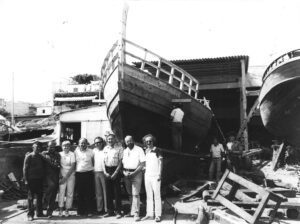
As the construction of the hull was advancing, a persistent question was the absence of caulking on the ancient ship. Michael Katzev and Richard Steffy were adamant in stressing that the ancient ship had no caulking at all. However, it was obvious that the ancient ship, which was probably over half-a-century old when it sank, had lost its water-tightness and the lead-sheathing of the hull up to the load line had cured this problem. According to the excavator, this was a late repair meant to deal with the poor condition of the hull, which had been attacked by teredo worms. Thus, it was decided that there would be no caulking in the hope that after immersion in the sea the timber of the planking would expand to secure the necessary water-tightness. This process, known as staniarisma in Greek, was then used for small dinghies, but, as Giorgos Psarros, Manolis father, insisted, this could not apply to a 15-metre boat. “It will definitely sink”, he said. And indeed it did sink. When first launched (fig. 5), there was a slow but steady ingress of water and the ship sunk up to the bulwark. It still remained buoyant but semi-submerged for 48 hours. It was then noted that the timber had slowly expanded and, after pumping the water out of the hold, the Kyrenia II remained afloat, high and proud. No caulking was ever needed, and during the following years of her repeated voyages the hull remained reasonably dry. A hand-operated pump dealt with the minimal ingress of water, usual in all traditional wooden hulls.
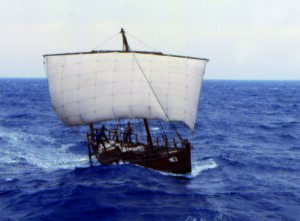
During 1984 and 1985 the Kyrenia II had numerous short sea trials, sailing mainly in the waters of the Saronic Gulf : the marina of Zea became her homeport (fig. 6). Navigation under different winds, as well as anchoring, berthing in various positions, and storing amphorae were experienced. Then, during autumn of 1986 and 1987, two long voyages to and from Cyprus were carried out.
Recruiting the captain and the right crew and planning the itinerary of those extended voyages was a great responsibility. The discovery of the ancient ship and the construction of a full-size replica had made headlines in the Greek press, and the fact that the port of Kyrenia had been occupied by Turkish armed forces since 1974 transformed the planned sea trials and the crossing to Cyprus into a mythical venture. Every Greek athlete-sailor, and in particular those who had participated and won Olympic titles, considered that they should be selected for this ultimate honour and be part of the crew. The ship had become an emblem of Greek seamanship and every island in the Aegean expected to be included in its itinerary. There are hundreds of historic islands, whose seamanship goes back to the Homeric era, and these seas have experienced voyages of heroes and gods since the dawn of history. So, selecting the captain and crew was as difficult as fixing the itinerary.
During the numerous and lengthy interviews with candidates, both for skipper and crew, I tried to make clear that this was not an adventure but a scientific endeavour : the crew had to go back in time, take a leap backwards of some 2,300 years. It was absolutely necessary to put aside all innovations that have gradually made navigation safer and more comfortable. A scale model of the Kyrenia II was used to explain the differences in construction and the difficulties that the crew would face using a different steering mechanism and a square sail. To my question, “How will you use this square sail under different wind directions ?”, the answer, “I will reef it and make it into a lateen sail” was sufficient to disqualify the candidate. It is known that the lateen sail is a late invention and to jump forward some six centuries would have been to fake the sea trials and the experimental voyages.
The 600 nautical-mile voyage from Piraeus to Cyprus in September 1986 was made in a total of 25 days, but as the ship stopped at several islands, she in fact sailed for only 15 days. The long, non-stop crossing from Kastellorizo to Paphos was dictated by the fact that political tensions forbade a call in a Turkish port. It was decided that Antonis Vassiliadis, a most experienced skipper whose curriculum vitae included a singlehanded Atlantic crossing, would be the captain for the eastbound voyage. Six crew members were selected, but only three to four manned the ship at any one time. The westbound voyage was an exclusively experimental voyage that started in Paphos on 8 September 1987 and ended in Zea, Piraeus after 19 days. The ship covered a total distance of 660 nm in 12 days : seven days were spent in port. The captain was Glafkos Kariolou, son of the Cypriot diver who had first found the ancient ship, and the crew was exclusively composed of experienced sailors from Kyrenia. Glafkos had been a crew member on the Greece to Cyprus voyage and had acquired the necessary experience on how to handle the intricate steering mechanism, the special rig and the square sail.
On both voyages scholars such as Patrice Pomey closely followed the course of our experiment. From the deck of the accompanying ship, and often embarking on the Kyrenia II itself, they attentively noted all details relevant to the weather conditions, the behaviour of the ship, as well as comments from the captain and crew (3).
The construction of the Kyrenia II was most helpful in understanding the shell-first method and other structural details (4), while the over 2000 nautical miles covered in sea trials and experimental voyages helped to provide first-hand information on how a ship behaved when steered by two quarter-oars and propelled by a square sail. It proved beyond any doubt that a ship can be built shell-first, and that the shell-first method produces a sturdy well manoeuvrable hull. This method of construction, where first the strakes of the hull planking are placed, starting from the keel and moving upwards, and only later are the frames fastened to the planking as buttresses to the action of the sea, has been found on every ancient hull in the eastern Mediterranean up to late antiquity. The Kyrenia II proved to be extremely seaworthy, moving at a cruising speed of 3 to 4 knots. There were moments when with a fair stern wind and ideal sea conditions a maximum speed of 10 knots was attained.
Besides the scientific aspects related to the construction and the experimental voyages, there were several practical matters in the project that required careful coordination. It was a costly project notwithstanding the fact that a lot of work was on a voluntary basis. It involved a diversity of skills, and coordination was complicated and time consuming. The voyages in particular required numerous bureaucratic formalities and a multitude of administrative matters had to be solved. Patience and perseverance were as important as keeping to the criteria of a scientific experiment.
The list of those who took part in the first phase of the construction of the ship and then those involved in the second, related to the sea trials and experimental voyages, is too long and cannot be enumerated in the limited space of a concise article. The list includes : the shipwrights and their assistants, who worked on the construction of the ship ; the blacksmith and his assistants, who hand-forged hundreds of different bronze nails as well as other metal fittings ; the rigger involved in the intricate making of the standing and running rigging ; the sail maker ; the naval architects, who supervised every phase of construction ; and then draftsmen and ship modellers, who produced scale drawings and models of the ship. In addition, there were archaeologists and historians, who painstakingly researched for answers to technical details, the two skippers and the crew members, who made the sea trials and the experimental voyages possible, and the observers with their most valuable observations and records. But we should also acknowledge the contribution of lawyers, surveyors, marine consultants and officers of the coastguard for the registration of this unusual ship and for dealing with the many formalities required for the innumerable clearances and entries into tens of ports (5). The project is greatly indebted to the Greek Ministry of Culture and the Ministry of Merchant Marine, as well as to the Hellenic Navy. Without their constant support the trial voyages would not have been as extensive.
Needless to say, the project was made possible due to the scientific data gathered over years of research by the team of American archaeologists who led the excavation and the reassembling of the ancient Kyrenia shipwreck. Without the generous contributions of Michael Katzev, Richard Steffy and Susan Katzev, it is probable that I would not have attempted the Kyrenia II project.
The voyages to and from Cyprus concluded the project in the most satisfactory manner, however, I would like to stress that nautical experimental archaeology is not an adventure. It does not involve a hazardous crossing, it is not a unique achievement designed to be difficult to repeat. A scientific project involving the construction and sailing of an ancient ship should refer to a known ship that has existed, the remains of which are tangible, and not to a mythical, legendary vessel. We have to bear in mind that we are trying to recreate a voyage that was repeated regularly, over and over again, for decades and for centuries. Such trial voyages should be conducted with the maximum of security for the ship, its crew and observers.
In order to ensure safe sailing from Piraeus to Cyprus, the Kyrenia II was first escorted by a minesweeper of the Hellenic Navy, the Aidona, for the stretch Piraeus-Rhodes, jointly with the three-masted training ship Eugenios Eugenidis of the Greek merchant navy (6). From Rhodes to Paphos, she was escorted by a naval destroyer, the Aegean. On the westbound voyage from Paphos to Piraeus the same destroyer and a large oceangoing salvage tugboat, the Hellas, escorted the Kyrenia II (7).
Alongside the scientific achievements, it was considered proper for the Kyrenia II to promote the Greek nautical tradition. Thus, the ship was used as an exhibit on various occasions abroad as well as in Greece. She was transported to New York on the deck of a container ship in 1986 and took part in the impressive naval parade commemorating the centennial of the Statue of Liberty. Thereafter, the ship was exhibited in the Mystic Seaport Museum for two months. A voyage to the old capital of Japan, Nara, followed on the occasion of the Silk Road exhibition in 1988, and a year later she was transported to Hamburg for the festivities commemorating the 700th anniversary of the city’s foundation. Her last appearance abroad was in Seville on the occasion of the 1992 World Fair. Back in Greece the ship was exhibited in various towns on occasions related to nautical events. It was then decided that she would be transported to Cyprus to be permanently exhibited in a new museum, the Thalassa Museum in Aghia Napa, which was built for this purpose.
During the last three years of her stay in Greece while the museum in Cyprus was under construction, the ship was cared for by youngsters following a therapy programme against drug addiction. They were properly trained in the maintenance of the ship as part of a successful rehabilitation programme run by the Centre for Therapy of Dependent Persons (8).
The Athenian trireme project
The Kyrenia II project in experimental archaeology was the starting point for two further attempts conducted in Greece : the Athenian trireme, involving the construction, the rowing and sailing of a 37 m warship of Greek Classical times, and the papyrella, an experiment designed to investigate the possibilities of the transportation of obsidian from the island of Milos in Mesolithic times.
In 1982, when the construction of the Kyrenia II was progressing, I was invited by Professor John Morrison, president of the Trireme Trust, to take part in an advisory meeting held at the National Maritime Museum, Greenwich. John Morrison was the leading specialist on Athenian triremes and his first article on those complex war machines dated to 1938. It had been decided that, with the collaboration of John Coates, the then retired Chief Naval Architect of the Royal Navy, and a team of British scholars that included Eric McKee specialising in nautical experimental archaeology, the construction of an Athenian trireme was to be undertaken in England. The aims of the Greenwich meeting were to present the project to an audience of specialists, explain what was to be attempted and hear their comments. After the meeting we were shown a full-scale replica of a section of the proposed trireme that comprised the seats for six rowers accommodated on three banks. The blades of the oars could move in a miniature circular pond.
This project was very different from the duplication of the ancient Kyrenia ship as no ancient warship has ever been found in the Mediterranean and the intricate study and construction plans of the trieres, propelled by 170 oarsmen, accommodated on three banks, was not based on archaeological evidence9 but on ancient sources as well as the scant remains of iconographic evidence.
The project was almost ready to take off and the necessary funds had been secured in England along with the cooperation of the Royal Navy. I was not aware before the Greenwich meeting of the details of the project, though I vaguely knew of the attempts to construct such a complex ship that had failed in the past. The best known was that of Napoleon III, which had resulted in a total fiasco. The project was indeed challenging and when, at the end of the meeting, I had the opportunity to talk privately to John Morrison I asked if he would consider building the Athenian trireme in Greece. There were certainly advantages in doing so as large wooden hulls were still being built in Greece, the skilled labour existed and, when the time came for sea trials, an experiment in rowing in the waters off Salamis would be more appropriate than in the very different conditions of the North Sea.
Upon my return to Athens, the Minister of Culture Melina Mercuri invited John Morrison, John Coates and Erik McKee to discuss the building of the Athenian trireme in Greece. It turned out to be a successful Anglo-Hellenic project. John Morrison’s dream came true and the trieres was built in a yard at Keratsini, near Piraeus, between 1985 and 1987 with Greek funds and under the complete supervision of the British Trireme Trust with the cooperation of the Hellenic Navy (10). It was during the summer of 1987 that John Morrison sat proudly on the trierarchus seat while his trireme was oared through the Bay of Poros for the first sea trial (11).
The extended sea trials proved that the rowers can comfortably operate seated on three levels and that the two square sails can secure a speed of up to 9 knots. The results of this most important attempt in nautical experimental archaeology have been extensively published in articles and books (fig. 7‑812).
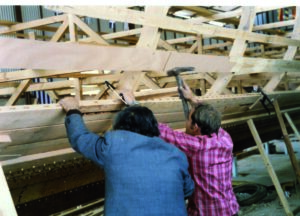
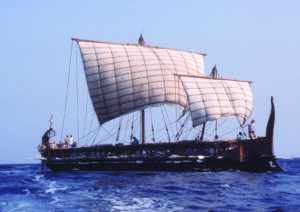
In 1993 the Athenian trireme was transported to London and rowed on the Thames to mark the celebration of 2,500 years of Athenian democracy. The ship is now exhibited in The Park of Maritime Tradition in Paleo Faliro Bay.
The papyrella project
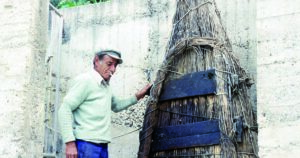
In 1987, when the trireme construction was nearly completed I decided to build a papyrella, a duplicate of a local primitive papyrus raft of a sort that had been built for generations in Corfu (fig. 9). I was hoping to answer the question posed by Professor Thomas Jacobsen, the excavator of the Franchthi Cave (13), as to how the obsidian found in that cave and dated to the Mesolithic period had been transported some 9,000 years ago from the volcanic island of Milos in the southern Cyclades. The shortest sea route would involve a lengthy crossing of over 70 nm to the coast of Lavrio, the closest point on the mainland.
The papyrella project was a whole different challenge from building and sailing the Kyrenia II as obviously there were no surviving prehistoric rafts to duplicate nor any ancient sources or iconographic evidence of such sea craft. Based on the information obtained in Corfu from the builder of the last existing papyrella, a 6-metre raft was built using papyrus from the last area where it still grows in Greece (14). It took seven days for six paddlers, paddling during daytime and resting ashore at night, to hop from island to island and cover the 78 nm distance that separate Lavrio from Milos (fig. 10). The experiment was meticulously documented and the results published in every detail15. This certainly did not prove that the Milian volcanic vitreous rock that revolutionised the microlithic making of tools in the Mesolithic was transported by rafts. The project only constituted an “educated guess”, proposing that a simple raft made of papyrus with the stone tools that were then available could transport obsidian from Milos to the Franchthi Cave.
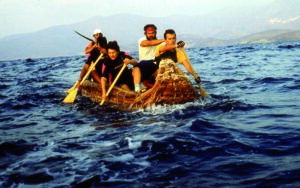
The papyrella is now exhibited in the Thalassa Museum at Aghia Napa, alongside the Kyrenia II.
Conclusion
The Kyrenia II, the Athenian trireme Olympias and the papyrella, constitute three attempts in nautical experimental archaeology with three very different seagoing craft. The Kyrenia II answered mainly the question as to the possibility of shell-first construction, the Athenian trireme solved the long standing query regarding the repartition of 170 oarsmen on three levels, while the papyrella indicated that a small papyrus raft can be paddled across the often rough waters off the Cyclades.
Notes
1 See the selected bibliography at the end of this contribution.
2 Caiques, kaiki in Greek, is the wider term for a traditional wooden boat ; the particular type of caiques built on the island of Symi was the trechandiri. There are many other distinct types which all differ because of the shape of the hull and the rig. The most common are the perama, the varkalas, the saita and the tserniki : the names are generally common to both Greek and Turkish shipbuilding traditions.
3 The scientists-observers on the voyage to Cyprus were (in alphabetical order) Charalambos Kritzas, Nicos Lianos, Patrice Pomey, Yiannis Vychos : on the homeward voyage, Michael and Suzan Katzev and Richard Steffy.
4 During the various phases of its construction a number of scientists specialising in ancient ship construction visited the Psarros yard. Besides the repeated visits of Michael and Susan Katzev and Richard Steffy I can mention (in alphabetical order) : John Coates, Honor Frost, Erik McKee, John Morrison, Patrice Pomey, Peter Throckmorton, A.I. Tzamtzis, Michael Wedde.
5 One should mention that the Kyrenia II would have failed any of the surveys required by the maritime authorities, as she satisfied none of the basic modern safety requirements and, if assistance were needed, she depended mainly on the accompanying vessel(s). Thus, she was registered as No. 1 on a new registry for Greek vessels used for « experimental archaeology ».
6 Regretfully, this was the very last voyage for the 53-metre Eugenios Eugenidis, formerly the Sunbeam II. She was laid up to become a museum-ship : a wishful intention that has still to be realised !
7 The Hellas was graciously placed at the disposal of the project by her owner John Latsis.
8 The ship was transported to the Paremvassi Therapy Community near Rafina, Attica, for a year, then to another similar centre, the Nostos Therapy Community on the island of Salamis.
9 The Lenormant relief and the Dal Pozzo drawing, as well as the partial remains of a Zea shipshed were the only archaeological evidence.
10 Commander Stavros Platis a naval architect supervised the project on behalf of the Hellenic Navy.
11 Sea trials were carried out in 1987, 1990, 1992 and 1994.
12 See a selected bibliography at the end of this article.
13 The cave of Franchthi is located in the Argolis near the town of Koilada.
14 Papyrus still grows in Lake Kavourolimni, near the village of Liapades in north-western Corfu.
15 See the extended bibliography at the end of this article.
Abbreviations
Tropis I
H. Tzalas (ed.), Tropis I, Proceedings of the 1st International Symposium on Ships Construction in Antiquity, Pireus, 1985, Athens, 1989, Hellenic Institute for the Preservation of Nautical Tradition.
Tropis II
H. Tzalas (ed.), Tropis II, Proceedings of the 2nd International Symposium on Ships Construction in Antiquity, Delphi, 1987, Athens, 1990, Hellenic Institute for the Preservation of Nautical Tradition.
The “Kyrenia II”
Katzev M.L.
1990 An Analysis of the Experimental Voyages of Kyrenia, in Tropis II, p. 245‑255.
Katzev Womer S.
2007 The Ancient Ship of Kyrenia, Beneath Cyprus Seas, in P. Valavanis (ed.), Great Moments in Greek Archaeology, Los Angeles, The J. Paul Getty Museum, p. 286‑299.
Katzev M.L., Katzev Womer S.
1989 « Kyrenia II » : building a replica of an Ancient Greek merchantman, in Tropis I, p. 163‑175.
Steffy R.J.
1985 The Kyrenia Ship : An Interim Report on its Hull Construction, AJA, 38.1, p. 71‑101.
Steffy R.J
1994 Wooden Ship Building and the Interpretation of Shipwrecks, College Station, Texas A&M University Press.
Tzalas H.E.,
2007 The Kyrenia II. An Attempt of Experimental Archaeology, in P. Valavanis (ed.), Great Moments in Greek Archaeology, Los Angeles, The J. Paul Getty Museum, p. 300‑305.
The “Athenian Trireme”
Coates J. F.
1989 The Trieres, its design and construction, in Tropis I, p. 83‑90.
Coates J. F., Platis S. K., Shaw J. T.
1990 The Trireme Trials 1988, Oxford, Oxbow books.
Lehmann, L. Th.
2001 Remarks on the hypozoma, in H. Tzalas (ed.), Tropis VI, Proceedings of the 6th International Symposium on Ships Construction in Antiquity, Lamia, 1996, Athens, Hellenic Institute for the Preservation of Nautical Tradition, p. 389‑395.
Morrison J.S.,
1989 The Trieres reconstruction ; values and authenticity ; the nature of the evidence, in Tropis I, p. 211‑216.
Morrison J.S.,
1996 Greek and Roman Oared Warships, 399‑30 B.C., Oxford, Oxbow books.
Morrison J. S., Coates, J. F.
1986 The Athenian Trireme, The History and Reconstruction of an ancient Greek Warship, Cambridge, Cambridge University Press.
Morrison J. F., Williams R. T.
1997 Greek Oared Ships 900‑322 B.C., Cambridge, Cambridge University Press (1st edition 1968).
Platis S.
1990 The shipbuilding work of Trieres ; Problems faced-Lessons learned, in Tropis II, p. 273.
Robert O.T.R.
1990 Rigging the Athenian Trireme, in Tropis II, p. 287‑300.
Shaw T. (ed.)
1993 The Trireme Projects : Operational Experience 1987‑1990, Lessons Learnt, Oxford, Oxbow books.
Tilley A.
2004 Seafaring on the Ancient Mediterranean, New Thoughts on Triremes and Other Ancient Ships, Oxford, British Archaeological Reports (BAR, Int. Series, 1268).
The “Papyrella”
Tzalas H.E.,
1995 On the obsidian trail : With a Papyrus craft in the Cyclades, in H. Tzalas (ed.), Tropis III, Proceedings of the 3rd International Symposium on Ships Construction in Antiquity, Athens, 1989, Athens, Hellenic Institute for the Preservation of Nautical Tradition, p. 441‑469.
Tzalas H.E.,
2003 The ships of the Greeks – From the rafts and dugouts to the giants of the sea of Hellenistic Times, in The Voyage from Ancient Time to Modern Age, Athens, Research National Foundation, p. 37‑46.
Tzalas H.E.,
2008 Η πρώιμη θαλάσσια μεταφορά Οψιανού της Μήλου / Der Transfer von Obsidian aus Milos in der prähistorischen Zeit, in A. Kyriatsoulis (ed.), Tagung – Austausch von Gütern, Ideen und Technologien in der Ägäis und im östlichen Mittelmeer von der prähistorischen bis zu der archaischen Zeit, Ohlstadt/Obb. Deutschland, 2006, Weilheim, Obb. : Verein zur Förderung der Aufarbeitung der Hellenischen Geschichte, p. 157‑162.
Tzamtzis A. I.,
1990 Papyrella : Remote descendant of a Middle Stone Age craft, in Tropis II, p. 329‑332.


